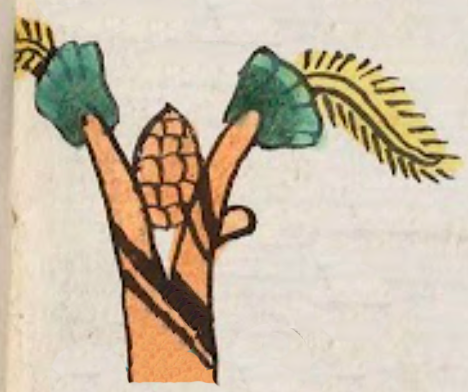ocotl (Mdz39r)
This element for an ocote pine tree (ocotl) has been carved from the compound glyph for the place name Ocoapan. The pine tree has two trunks, each one with green foliage and yellow blossoms. The trunks have diagonal black lines, thick and thin, which are so typical of the way trees are indicated in the Codex Mendoza. Between the two trunks appears to be a pine cone, which may be providing a clue that this is not just any tree (cuahuitl), but a torch pine. One of the branches, coming out the back of the tree, has been cut off. Perhaps it was cut for its torch material.
Stephanie Wood
The tree called ocote today in Mexican Spanish was used for obtaining fat wood that was useful for torches. It has the name pinus montezumea, and an online photograph of it shows the pine cone that might be represented in this compound glyph. Googling ocote will also bring up images of the fat wood. The black stripes (tlilcuahuitl) on the tree trunks provide the phonetic value that underlines this is a standard tree, cuahuitl, something I discovered independently, but which has also been pointed out by Brígida von Mentz ("De árboles, raíces, y locativos en la iconografía del México antiguo," Tlalocan 15, 2008, 216–219).
Stephanie Wood
c. 1541, but by 1553 at the latest
Stephanie Wood
pine trees, pinos, ocotes, torch pines, trees

oco(tl), torch pine tree, https://nahuatl.wired-humanities.org/content/ocotl
tlilcuahui(tl), black stripe(s), https://nahuatl.wired-humanities.org/content/tlilcuahuitl
Sobre las Aguas de los Pinos, o Sobre las Aguas de los Ocotes
Stephanie
Codex Mendoza folio 39 recto, https://digital.bodleian.ox.ac.uk/objects/2fea788e-2aa2-4f08-b6d9-648c00..., image 88 of 188.
Original manuscript is held by the Bodleian Libraries, University of Oxford, MS. Arch. Selden. A. 1; used here with the UK Creative Commons, “Attribution-NonCommercial-ShareAlike 3.0 License” (CC-BY-NC-SA 3.0)



